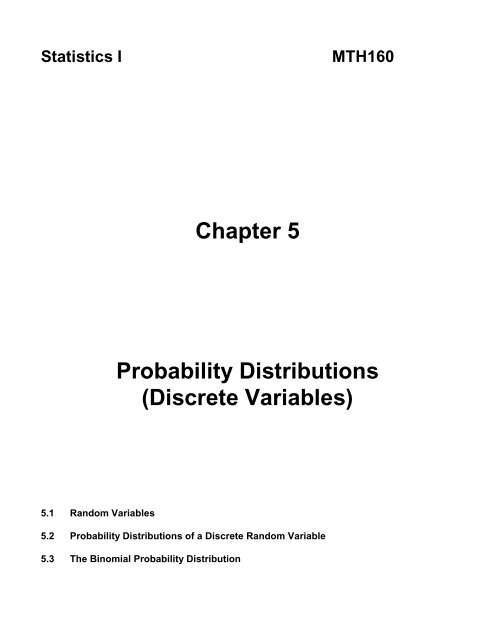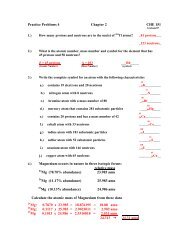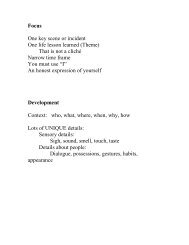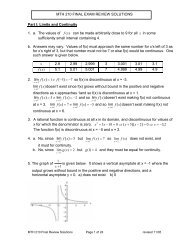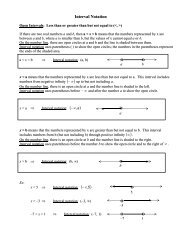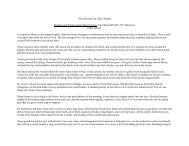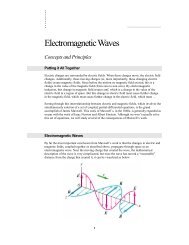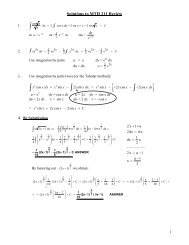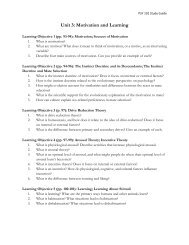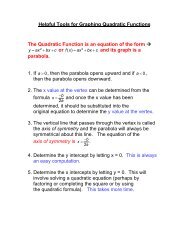Chapter 5 Probability Distributions (Discrete Variables)
Chapter 5 Probability Distributions (Discrete Variables)
Chapter 5 Probability Distributions (Discrete Variables)
You also want an ePaper? Increase the reach of your titles
YUMPU automatically turns print PDFs into web optimized ePapers that Google loves.
Statistics I<br />
MTH160<br />
<strong>Chapter</strong> 5<br />
<strong>Probability</strong> <strong>Distributions</strong><br />
(<strong>Discrete</strong> <strong>Variables</strong>)<br />
5.1 Random <strong>Variables</strong><br />
5.2 <strong>Probability</strong> <strong>Distributions</strong> of a <strong>Discrete</strong> Random Variable<br />
5.3 The Binomial <strong>Probability</strong> Distribution
MTH 160<br />
Statistics I<br />
Brigitte Martineau <strong>Chapter</strong> 5<br />
What is a random variable?<br />
5.1 Random <strong>Variables</strong><br />
Notes:<br />
<br />
<br />
Examples of Random <strong>Variables</strong><br />
<br />
Let the number of computers sold per day by a local merchant be a random variable.<br />
Integer values ranging from zero to about 50 are possible values.<br />
<br />
Let the time it takes an employee to get to work be a random variable. Possible values<br />
are 15 minutes to over 2 hours.<br />
<br />
Let the volume of water used by a household during a month be a random variable.<br />
Amounts range up to several thousand gallons.<br />
<br />
Let the number of defective components in a shipment of 1000 be a random variable.<br />
Values range from 0 to 1000.<br />
<strong>Discrete</strong> versus Continuous Random <strong>Variables</strong><br />
<strong>Discrete</strong> Random <strong>Variables</strong>:<br />
A quantitative random variable that can assume a __________________ number of values.<br />
Also known as a ___________________<br />
Continuous Random <strong>Variables</strong>:<br />
A quantitative random variable that can assume an _______________________ number of<br />
values.<br />
Also known as a ____________________<br />
Page 2 of 14
MTH 160<br />
Statistics I<br />
Brigitte Martineau <strong>Chapter</strong> 5<br />
5.2 <strong>Probability</strong> <strong>Distributions</strong> of a <strong>Discrete</strong> Random Variable<br />
Let’s start with an example.<br />
Let’s say we are looking at the random variable x = Number of tails when 2 coins are tossed<br />
What are the possible values for x?<br />
Let’s make a table with all the possible values of x and their respective probability:<br />
P(x = 0) P( zero tail) =<br />
P(x = 1) P( one tail) =<br />
P(x = 2) P (two tails) =<br />
The table we just created is called a _______________________ ____________________<br />
What is a <strong>Probability</strong> Distribution?<br />
<br />
<br />
<br />
A ___________________ of the probabilities associated with each __________ of a<br />
random variable.<br />
The probability distribution is a ___________________ distribution<br />
It is used to represent ____________________<br />
Note:<br />
<br />
<br />
What is a <strong>Probability</strong> Function?<br />
Page 3 of 14
MTH 160<br />
Statistics I<br />
Brigitte Martineau <strong>Chapter</strong> 5<br />
Examples:<br />
The probability distribution of a modified die is as follow: P( x) x / 6 for x 1,2,3<br />
X 1 2 3<br />
P(x)<br />
<br />
Could you find a probability distribution that describes the probabilities obtained when<br />
rolling a regular die?<br />
X 1 2 3 4 5 6<br />
P(x)<br />
Properties of <strong>Probability</strong> Distribution<br />
Property 1: 0 Px<br />
( ) 1<br />
<br />
Property 2: Px ( ) 1<br />
all x<br />
Examples:<br />
The number of people staying in a randomly selected room at a local hotel is a discrete<br />
random variable ranging in value from 0 to 4. The probability distribution is known and<br />
given in the form of a chart below.<br />
X 0 1 2 3 4<br />
P(x) 1/15 2/15 3/15 4/15 5/15<br />
a) Verify that this distribution meets the 2 properties of a probability distribution.<br />
b) Express the distribution as a probability function.<br />
Page 4 of 14
MTH 160<br />
Statistics I<br />
Brigitte Martineau <strong>Chapter</strong> 5<br />
c) Construct a histogram of the Hotel Room probability distribution.<br />
NOTES:<br />
‣ The histogram of a probability distribution uses the physical ________ of each<br />
bar to represent its assigned probability<br />
‣ In the Hotel Room probability distribution: the width of each bar is ______, so<br />
the height of each bar is equal to the assigned probability, which is the area of<br />
each bar.<br />
‣ The idea of area representing probability is important in the study of<br />
___________________ _______________ variables<br />
x<br />
Is P( x) for x 1,2,3,4 a probability function? Why?<br />
9<br />
x<br />
P(x)<br />
Page 5 of 14
MTH 160<br />
Statistics I<br />
Brigitte Martineau <strong>Chapter</strong> 5<br />
Mean and Variance of <strong>Discrete</strong> <strong>Probability</strong> Distribution<br />
Goal:<br />
To describe the ________________ and the _______________________ of a population<br />
Let’s review first!<br />
1. The mean of a sample is represented by ___________.<br />
2. s 2 and s are the ____________ and _____________ ____________ of the _________.<br />
3. s 2 , and s are called ____________ _________________.<br />
4. µ (lowercase Greek letter “mu”) is the _______________ of the _________________<br />
5.<br />
2<br />
(“sigma squared”) is the ______________ of the________________.<br />
6. σ (lowercase Greek letter “sigma”) is the _____________ _________________ of the<br />
_________________ ___.<br />
2<br />
7. µ, σ and are called _______________ ________________.<br />
2<br />
(A parameter is a constant. µ, σ and are typically unknown values.)<br />
The Mean of a <strong>Discrete</strong> Random Variable<br />
The mean, µ, of a discrete random variable x is found by ____________________ each<br />
possible value of x by its own probability and then adding all the _________________ together.<br />
<br />
<br />
xP( x)<br />
<br />
Notes:<br />
The mean is not necessarily a value of the random variable<br />
The mean ________ is a population parameter that is usually unknown. We would like to<br />
____________________ its value.<br />
The Variance of a <strong>Discrete</strong> Random Variable<br />
Page 6 of 14
MTH 160<br />
Statistics I<br />
Brigitte Martineau <strong>Chapter</strong> 5<br />
2<br />
The variance, , of a discrete random variable x is found by _________________ each<br />
possible value of the squared deviation from the mean,<br />
2<br />
( x )<br />
, by its own probability and then<br />
_____________ all the products together.<br />
2<br />
<br />
<br />
<br />
<br />
<br />
<br />
<br />
<br />
<br />
<br />
<br />
x <br />
2<br />
x P x<br />
<br />
2<br />
P( x)<br />
<br />
<br />
<br />
( ) <br />
<br />
xP( x)<br />
2 2<br />
<br />
x P( x)<br />
<br />
<br />
<br />
<br />
<br />
2<br />
The Standard Deviation of a <strong>Discrete</strong> Random Variable<br />
<br />
2<br />
<br />
Examples:<br />
Find the mean, the variance and the standard deviation of the following probability<br />
x<br />
distribution: P( x) for x 1 and 2<br />
3<br />
Page 7 of 14
MTH 160<br />
Statistics I<br />
Brigitte Martineau <strong>Chapter</strong> 5<br />
<br />
The number of standby passengers who get seats on a daily commuter flight from<br />
Boston to New York is a random variable, x, with probability distribution given below. Find<br />
the mean, variance, and standard deviation.<br />
x<br />
P(x)<br />
0 0.30<br />
1 0.25<br />
2 0.20<br />
3 0.15<br />
4 0.05<br />
5 0.05<br />
Total<br />
Page 8 of 14
MTH 160<br />
Statistics I<br />
Brigitte Martineau <strong>Chapter</strong> 5<br />
5.3 - The Binomial <strong>Probability</strong> Distribution<br />
Before we start this section, let us review the concept of factorial.<br />
Factorial means the product of a particular set of integers and denoted by !<br />
4! <br />
12! <br />
x! <br />
0! <br />
Suppose you are given a three-question multiple-choice quiz. You have missed the last week of<br />
class and have not read the material in your textbook. You decide to take the quiz and just<br />
randomly guess all the answers. Let’s take the quiz:<br />
1. A B C D<br />
2. A B C D<br />
3. A B C D<br />
<br />
<br />
<br />
<br />
<br />
Are questions 1, 2 and 3 independent or dependent events? ______________________<br />
How many questions do you think you answered correctly? _______________________<br />
What do you think is the probability that you got 100% on the quiz? _________________<br />
What do you think is the probability that you got 0% on the quiz? ___________________<br />
What do you think would be the class average? ________________________________<br />
Let’s look at all the possibilities using a tree diagram:<br />
Page 9 of 14
MTH 160<br />
Statistics I<br />
Brigitte Martineau <strong>Chapter</strong> 5<br />
Question:<br />
For each individual question, what is the probability that you got the right answer? ___<br />
The probability that you got the wrong answer? ___ Why?<br />
Let x = a random variable representing the number of correct answers.<br />
P(x = 0) =<br />
P(x = 1) =<br />
P(x = 2) =<br />
P(x = 3) =<br />
This last experiment is known as a Binomial <strong>Probability</strong> Experiment<br />
What is a Binomial <strong>Probability</strong> Experiment?<br />
An experiment that is made of _________________ trials that possess the following properties:<br />
<br />
<br />
There are _____ repeated independent trials<br />
Each trial has two possible outcomes: a _________________ or a ______________<br />
P(success) = _______, P(failure) = __________ and ___ ___ 1<br />
<br />
The binomial random variable x is the _________ of the number of successful trials that<br />
occur; x may take any integer value from 0 to n.<br />
Examples<br />
1) Let’s look at our quiz<br />
<br />
Trials<br />
n :<br />
Success: Failure:<br />
p : q :<br />
x :<br />
Page 10 of 14
MTH 160<br />
Statistics I<br />
Brigitte Martineau <strong>Chapter</strong> 5<br />
2) A die is rolled 20 times and the number of “fives” that occurred is reported as the random<br />
variable. Explain why x is a binomial random variable.<br />
<br />
Trials<br />
n :<br />
Success: Failure:<br />
p : q :<br />
x :<br />
The Binomial <strong>Probability</strong> Function<br />
n<br />
x nx<br />
P( x) p q , for x 0,1,2,3,...<br />
x<br />
<br />
What is n <br />
?<br />
x<br />
<br />
What is<br />
p x ?<br />
What is q n x ?<br />
Page 11 of 14
MTH 160<br />
Statistics I<br />
Brigitte Martineau <strong>Chapter</strong> 5<br />
Examples:<br />
<br />
Back to our quiz, let us use the formula to find:<br />
Px ( 0)<br />
<br />
Px ( 2)<br />
<br />
Px ( 1)<br />
<br />
Px ( 3)<br />
<br />
<br />
Results from the 2000 census show that 42% of U.S. grandparents are the primary<br />
caregivers for their grandchildren (Democrat & Chronicle, “Grandparents as ma and pa,”<br />
July 8, 2002). In a group of 20 grandparents, what is the probability that exactly half are<br />
primary caregivers for their grandchildren? At most 19 are primary caregivers for their<br />
grandchildren?<br />
First let us check if this is a Binomial experiment.<br />
Trials n :<br />
Success:<br />
Failure:<br />
p : q :<br />
x :<br />
Page 12 of 14
MTH 160<br />
Statistics I<br />
Brigitte Martineau <strong>Chapter</strong> 5<br />
Using Tables (p. 807 - 809)<br />
It is also possible to use a table to compute the probabilities of a Binomial Experiment as long<br />
as n 15 and that p is listed in the table (0.01, 0.05, 0.1, 0.2, 0.3, 0.4, 0.5, 0.6, 0.7, 0.8, 0.9,<br />
0.95 and 0.99)<br />
Let’s use the table to answer the following questions:<br />
<br />
The survival rate during a risky operation for patients with no other hope of survival is<br />
80%. What is the probability that exactly four of the next five patients survive this<br />
operation?<br />
Success: p : n:<br />
Failure: q :<br />
<br />
If boys and girls are equally likely to be born, what is the probability that in a randomly<br />
selected family of six children, that there will be:<br />
Success: p : n:<br />
Failure: q :<br />
Exactly 4 boys<br />
Exactly 2 girls<br />
At least 3 boys<br />
At most 2 boys<br />
At most 5 boys<br />
Page 13 of 14
MTH 160<br />
Statistics I<br />
Brigitte Martineau <strong>Chapter</strong> 5<br />
Mean and Standard Deviation of the Binomial Distribution<br />
The mean and the standard deviation of the binomial distribution are as follow:<br />
Examples:<br />
Mean <br />
np<br />
S tan dard Deviation <br />
npq<br />
2<br />
Variance <br />
<br />
<br />
Find the mean and the standard deviation for the number of sixes seen in 50 rolls of a die.<br />
<br />
The probability of success on a single trial of a binomial experiment is known to be ¼. The<br />
random variable x , number of successes, has a mean value of 80. Find the number of trials<br />
involved in this experiment and the standard deviation of x .<br />
Consider the binomial distribution where n 4 and p 0.3<br />
o Find the mean<br />
o Find the standard deviation<br />
o Using Table 2, find the probability distribution and draw a histogram.<br />
Page 14 of 14


